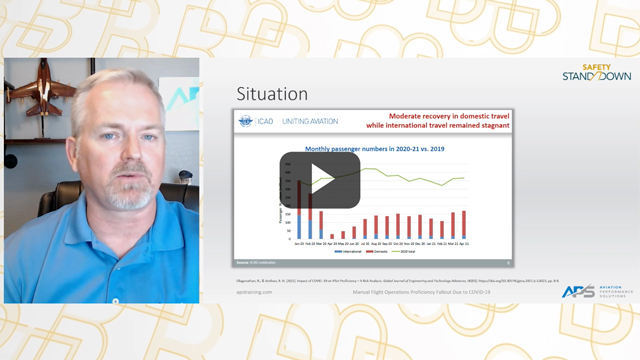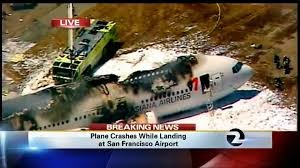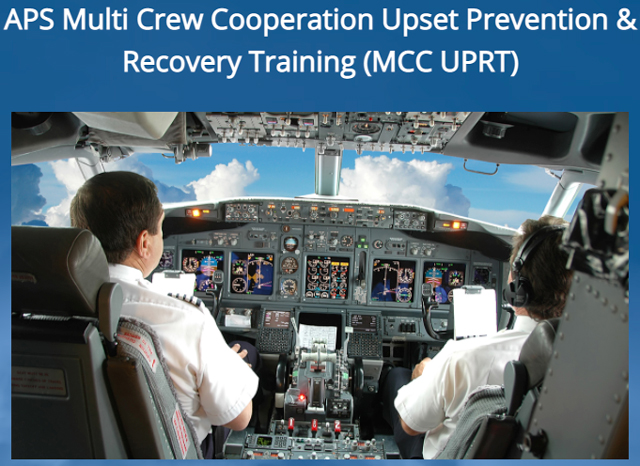Bombardier Safety Standdown Webinar by APS CEO, Paul BJ Ransbury
Watch Video: 1000% Increase in COVID-19 Era Manual Handling Incidents

As airplanes become more automated, every pilot knows that traditional ‘stick and rudder skills’ get sacrificed to accommodate automation management; the results are time, attention, and associated training and practice hours not being dedicated to core manual handling skills development and manual flight operation proficiency. How bad it is? As discussed in the above webinar by APS CEO, Paul BJ Ransbury, the FAA’s Operational Use of Flight Path Management Systems report, indicates a 60% occurrence of manual handling/flight control error in studied accident, incident, and LOSA data. That’s pre-COVID-19. The difference in today’s flight operations levels globally compared to 2019 dropped by 70% in 2020 and is forecast to be down 40% – 48% in 2021 meaning thousands of pilot are severely out of currency. The Aviation Safety Reporting System (ASRS) is showing a 500% to 1000% increase in manual handling related reports due to proficiency and currency (see above video for more). It’s time for the industry to follow APS’s lead to TAKE ACTION on this MANUAL HANDLING CRISIS. It’s real, it’s here, and it will last for years. There are numerous signals industry-wide concerning dwindling manual handling proficiency from the Survivable Catastrophes of the Boeing 737MAX Accidents addressed in detail by APS in 2020, to Asian Flight 214 back in 2013 … let’s have a closer look at the latter here …
Asian Flight 214 – Flight Path Automation vs. Manual Handling Proficiency

Asiana Flight 214 crashed short of the runway at the San Francisco International Airport on July 6, 2013, killing three and injuring more than 180. The NTSB Investigation concluded that mismanagement of approach (and mismanagement of automation was a big part of this) and inadequate monitoring of airspeed were the cause of the accident. There is another report which provides information regarding pilots use of automation that sheds light on this accident as well as the overall situation in general regarding pilot’s use of automation.
In the report mentioned above, released on the 5th of September 2013 titled “Operational Use of Flight Path Management Systems”, the Performance-Based Aviation Rulemaking Committee and Commercial Aviation Safety Team’s Flight Deck Automation working group concluded a wide-ranging, multi-year effort which updated the last report of this type published in 1996. The working group refined their evaluation and analysis down to 28 findings and 18 recommendations. The report states that: “Many of the findings and recommendations are interdependent and should not be considered in isolation.”, but here will focus on some specific issues relative to the contribution that Upset Prevention and Recovery Training (UPRT) can make towards improving manual handling skills. Here are the pertinent findings (Bold font added for emphasis): Finding 2 – Manual Flight Operations Vulnerabilities3 were identified in pilot knowledge and skills for manual flight operations, including:
- Prevention, recognition and recovery from upset conditions, stalls or unusual attitudes,
- Appropriate manual handling after transition from automated control,
- Inadequate energy management,
- Inappropriate control inputs for the situation,
- Crew coordination, especially relating to aircraft control, and
- Definition, development, and retention of such skills.
3 Vulnerability refers to characteristics or issues that render the system or process more likely to breakdown or fail when faced with a particular set of circumstances or challenges. In the body of the report, this is what the working group (WG) said about Manual Flight Operations:
“Manual handling skills, stick and rudder skill, basic airmanship, basic piloting skills – all of these are phrases used to describe pilot knowledge and skill sets that are a basic foundation of safe and successful flight. Therefore, pilots developing and maintaining the knowledge and skills for excellent manual flight operations is very important to the safety and effectiveness of aviation operations. The WG analyses of the LOSA [Line Oriented Safety Audits], accident and incident data show that this is an area of system vulnerability. Therefore, measures that promote the development and maintenance of pilot skills for manual flight operations remain important for the safety and effectiveness of aviation operations.” The report goes on to find that “pilots sometimes rely too much on automated systems and may be reluctant to intervene”. This clearly points to the interrelated nature of the findings since a chief reason for reluctance to intervene could be a lack of confidence in undeveloped or eroded manual handling skills. Over 60% of the accident reports reviewed by the WG identified a manual handling error as a factor in the accident. In examining the accidents and major incidents, the WG found the following as a summary of the types of manual handling errors identified in the investigative reports:
- Incorrect upset recovery,
- Inappropriate control inputs,
- Lack of correct manual handling (taking control of the aircraft manually) after autopilot or autothrottle/autothrust disconnect, in some cases because of lack of recognition of disconnect,
- Lack of monitoring/maintaining energy/speed, and
- Mismanagement of autothrottle/autothrust.
The primary emphasis in Upset Prevention and Recovery Training is to introduce new knowledge and skill that can help to reduce the number one cause of aviation fatalities in commercial and general aviation today: Loss of Control In-flight. It just so happens to be one of the best ways possible to improve manual handling skills which are necessary to complement today’s advanced automated flight path management systems.







Comments: